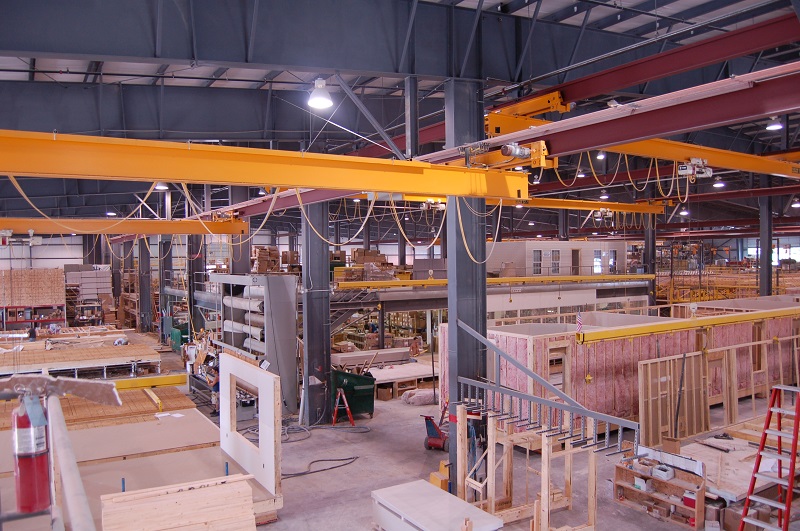Modular construction is a modern way to build. It’s about making parts of a building in a factory and then putting them together on site. This method has been around for years but has become more popular lately. Why? It’s faster, efficient, and often more precise than traditional building. From its early days to now, modular construction has grown and changed the way we think about building homes and offices. Let’s dive deeper into this exciting construction method.
Advantages of Modular Construction
When we think about modular construction, several benefits stand out:
Fast Build Times One top advantage is speed. Since factories make building parts, the site gets ready while parts are being made. This means homes and offices rise faster.
High Standards of Quality In a factory, conditions are controlled. This means better quality and fewer mistakes. Every part meets strict standards before it leaves the factory.
Good for the Planet Modular construction creates less waste. It also uses materials that are often eco-friendly. So, it’s a win for Mother Earth.
Saves Money With quicker build times and efficient methods, costs often drop. You get a great space without breaking the bank.
Make It Your Own Want a unique design? With modular, you can customize. You get a space that fits your style and needs. It’s all about choice and flexibility.
Basics of Modular Construction
Diving into modular construction, let’s understand the core elements:
What’s a Module? Think of a module like a building block. It’s a section of a house or office, made separately. Once ready, it joins other modules to form a complete building.
Creating Modules Factories use special tools and machines to make modules. Workers follow designs closely. Once a module is complete, it’s ready for transport to its final location.
Choosing the Right Stuff Modules are made from various materials. Often, it’s wood, steel, or concrete. These materials are chosen for their strength and how long they last. They ensure your space is both safe and cozy.
Comparison: Modular vs. Traditional Construction
When deciding between modular and traditional construction, consider these key differences:
Speed Matters Modular is often faster. While factories create modules, site work happens simultaneously. Traditional building? It usually goes step by step, taking more time.
Money Talks Modular can be more budget-friendly. Thanks to its efficiency and reduced waste, you might save more. Traditional methods might come with unexpected costs or delays.
Built Differently While both methods aim for strength, they have unique structures. Modular buildings come in pre-made blocks. Traditional ones are built piece by piece on site. Both are sturdy, but their build processes are distinct.
Design Principles in Modular Construction
Designing with modular construction in mind offers unique opportunities:
Thoughtful Planning Before anything gets built, there’s a plan. For modular, it’s crucial. The design must ensure modules fit together perfectly once they reach the site.
Make It Yours One big plus? Customization. Want an extra window or a unique room shape? Modular design often lets you tweak and tailor to your heart’s content.
Blending the Pieces The real magic? Taking separate modules and blending them seamlessly. The goal is a cohesive design, where everything looks and feels like a single, unified space.
Environmental Impact and Sustainability
Modular construction isn’t just smart; it’s green too. Here’s how:
Less Waste, More Savings Unlike traditional builds, modular construction reduces leftover materials. This means fewer resources go to waste, which is great for the environment.
Smart Energy Use Factories use energy efficiently when making modules. They aim to produce more while consuming less, reducing their carbon footprint.
Eco-friendly Materials Many modular builds prioritize green materials. Think recycled, renewable, or low-impact. This makes the end result both sturdy and eco-conscious.
Financial Benefits and Cost Analysis

Considering modular construction? Here’s how it might help your wallet:
Start Now, Save Later Yes, there’s an initial cost. But think long-term. Modular homes often have lower maintenance and energy costs, which means savings in the future.
Pay Fewer Workers With factory production, you often need fewer hands on deck. This can lead to lower labor costs compared to traditional building.
Time is Money Remember, modular is quick. Faster construction times can lead to reduced costs, from rental expenses to site management fees. The sooner it’s done, the sooner you save.
Global Perspective: Modular Construction Around the World
Modular construction isn’t just a trend—it’s a global movement. Let’s explore:
Standout Projects All over the world, modular buildings make headlines. From tall skyscrapers in New York to innovative homes in Japan, these projects showcase modular’s range and flair.
Different Places, Different Rules Countries have unique takes on modular. While some, like Sweden, widely adopt it for its efficiency, others are just warming up. And each country has its own rules—some strict, some lenient. It’s all about ensuring safe, quality builds.
How to Choose the Right Modular Construction Company
Picking the right team is key. Here’s a guide to help:
Listen to the Buzz Check out what people say. Good reviews? That’s a positive sign. Bad ones? Proceed with caution.
Past Work Speaks Volumes A company’s previous projects can show their skills. Explore their portfolio. Like what you see? That’s a promising start.
Trust the Badge Certifications matter. They show a company meets industry standards. Always ask about a company’s credentials to ensure top-notch quality.
Integration of Technology in Modular Construction
Tech and modular building go hand in hand. Here’s how:
Machines Take the Lead Automation speeds up module making. Machines ensure precision and consistency. It’s all about accuracy and pace.
BIM: A Game Changer Building Information Modeling (BIM) revolutionizes design. With BIM, teams visualize the final product, spot issues early, and make smart decisions.
Step into a New Reality Virtual and augmented reality tools offer a sneak peek. Before a single module is made, you can “walk” inside a virtual space. It’s a blend of imagination and innovation.
Joining Modules: Techniques and Challenges
Putting the pieces together is both art and science. Let’s delve in:
Holding It All Together Modules must connect securely. Methods range from bolts and screws to welding. Each connection ensures a tight fit.
Strength at the Seams Where modules meet, strength is vital. Techniques ensure the building remains solid, stable, and safe.
Making the Connections It’s not just about the frame. Water, electricity, and other utilities must flow smoothly. Special techniques weave these services between modules without a hitch. Challenges? Sure. But the right methods make all the difference.
Key Innovations in Modular Construction
As the modular world evolves, so do its methods. Here’s a look at the latest:
Material Magic Today’s modules aren’t just wood and steel. Advanced materials, like self-healing concrete or transparent wood, are making waves. They offer durability and a touch of the future.
Eco-Friendly Excellence Green designs are in vogue. Think solar-integrated roofs or rainwater harvesting systems. These designs make modular buildings even kinder to our planet.
Travel and Build Smarter Transporting large modules? That’s a challenge. Innovations in logistics and assembly methods ensure each module reaches its destination and fits perfectly in its new home.
Limitations of Modular Construction
While modular construction offers many benefits, there are also challenges to consider:
Bound by Design There might be limits on size or design. Complex shapes or vast sizes might not be ideal for modular methods.
On the Move Transporting big modules can be tricky. Roads, bridges, or tunnels may pose hurdles. Plus, longer distances can hike up costs.
Mind Over Matter Some folks might think modular is “less than” traditional. These perceptions, often based on myths, can overshadow the true value of modular builds. It’s essential to separate fact from fiction.
Maintenance and Durability
The story doesn’t end once a modular building is up. Let’s discuss its journey:
Staying Strong Good news: modular buildings are built to last. Their factory-made precision often results in solid, long-term performance.
Keep It Fresh Like any structure, modular buildings need care. Regular checks, timely repairs, and cleaning keep them in top shape. Following maintenance best practices ensures they stay looking and functioning well.
Age Gracefully Wondering about lifespan? Modular buildings often match or even outlast traditional structures. With proper care, they’re an investment that stands the test of time.
Navigating Regulatory and Zoning Challenges
Rules and regulations are part of the building journey. Here’s the lowdown for modular:
Getting the Green Light Before building, you need permits. Modular construction often requires specific permissions due to its unique process. Always check local rules first.
Safety First Whether it’s fire resistance or earthquake readiness, modular buildings must meet safety standards. These rules protect both the structure and its inhabitants.
Zone It Right Different areas have different rules. Some zones might welcome modular, while others might be stricter. Addressing zoning concerns early can save headaches down the road.
Opportunities in the Modular Construction Market
The modular construction landscape is ever-evolving. Let’s explore the promising horizons:
Sectors Seeing Surge
- Housing: With rising demand for affordable homes, modular housing is a hot sector.
- Hotels: Quick construction means hotels open faster, welcoming guests sooner.
- Healthcare Facilities: Modular designs allow for efficient, adaptable healthcare spaces, from clinics to full-scale hospitals.
Emerging Spaces New markets, especially in developing regions, are embracing modular. As urbanization grows, so does the need for swift, efficient building methods.
Looking Ahead Industry experts are bullish. Forecasts suggest modular construction will grow steadily, with innovations driving demand even higher. The future seems modular!
Pros and Cons Overview

Every method has its strengths and challenges. Here’s a snapshot for modular construction:
The Bright Side
- Speedy Builds: Faster construction means you move in or open doors sooner.
- Quality Control: Factory conditions ensure each module is top-notch.
- Eco-Friendly: Reduced waste and sustainable materials are kind to the planet.
- Cost-Effective: Efficient methods can lead to savings, both short and long term.
- Customizable: Modular design can adapt to personal preferences and needs.
The Other Side
- Design Bounds: Certain designs or sizes might be tough for modular methods.
- Transport Troubles: Moving large modules can pose challenges and costs.
- Perception Hurdles: Some may mistakenly view modular as inferior to traditional.
In the end, the method’s choice boils down to individual project needs, preferences, and circumstances.
Quality Assurance and Standards
Ensuring top-tier quality is paramount in modular construction. Here’s how it’s achieved:
A Commitment to Excellence Factories have controlled environments. This means each module is made under consistent conditions, minimizing errors and ensuring high standards.
Earning the Badge Certifications matter. Before a module leaves the factory, it often undergoes rigorous testing. Whether it’s for material strength, fire safety, or insulation, these checks ensure modules meet industry standards.
Voicing Concerns Quality concerns? They’re addressed head-on. Whether it’s through regular inspections, feedback loops, or third-party assessments, modular construction is all about continuous improvement and exceeding benchmarks.
Why Choose Modular Construction?
From individual homeowners to builders to communities, there are compelling reasons to opt for modular construction:
Through the Eyes of the Consumer
- Quick Turnaround: Less wait time means moving into your dream space sooner.
- Budget-Friendly: Potential savings without compromising on quality can be a big draw.
- Personal Touch: Customization options allow a space to truly reflect the individual’s taste.
From the Builder’s Desk
- Efficient Process: Streamlined construction reduces delays and unpredicted challenges.
- Controlled Environment: Building in a factory minimizes weather-related disruptions and enhances precision.
- Scalability: Tackle multiple projects simultaneously without needing to stretch resources thin.
For the Greater Good
- Environmental Care: Modular methods can mean less waste and more sustainable materials.
- Urbanization Ready: As cities grow, modular can address housing demands quickly.
- Job Creation: Modular factories can become employment hubs, boosting local economies.
Together, these factors make a strong case for considering modular construction in diverse scenarios.
Ready to Shape Your Modular Dream? We're Here to Help!
Navigating the world of modular construction can feel overwhelming, but with the right financial partner by your side, the journey becomes much smoother. Whether you’re just starting to entertain the idea or you’re deep into the planning stages, BuilderLoans.Net is here to provide the expertise and financial solutions tailored to your unique needs.
Why wait and wonder? Connect with us today and let’s make your modular dream a reality. Whether it’s insights, information, or in-depth financing inquiries, we’re just a call or click away.
🔗 Connect with BuilderLoans.Net Now and turn your construction aspirations into achievements!
Conclusion
As we wrap up this comprehensive journey from A to Z, we’ve unearthed the multifaceted world of modular construction. From its myriad benefits like speed, eco-friendliness, and customization to understanding its limitations and navigating through the regulatory maze, modular construction emerges as a dynamic and promising approach to building.
For anyone considering their next construction venture, modular offers a blend of tradition and innovation, encapsulating the best of both worlds. Whether you’re a homeowner dreaming of a new space, a builder aiming for efficiency, or a community leader looking to make sustainable choices, modular construction might just be the answer.
Embarking on a construction project is no small feat, but with the insights from this guide in your arsenal, you’re well-equipped to make an informed decision. As the world of construction continues to evolve, modular stands as a testament to where innovation, quality, and efficiency intersect. So, as you plan your next project, give modular a thought. It might just be the perfect fit.





